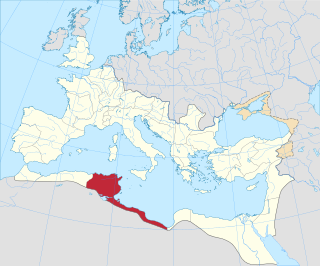Related Research Articles

Téboursouk is a town and commune in the Béja Governorate, Tunisia. It is located at 36° 27′ 26″N, 009° 14′ 54″E.
Serra is a titular see of the Catholic Church.

Vazari-Didda or Vazari Didda) was an Ancient city and bishopric in Roman Africa, which remains a Latin Catholic titular see.

The Diocese of Tubia is a suppressed and titular see in the province of Mauritania Caesariensis of the Roman Catholic Church. Tubia was a city in North Africa during the Roman, Byzantine and Vandal empires that is identifiable with the ruins of Henchir-Toubia.

Auzegera was a Roman-Berber town in the province of Africa Proconsularis and in late antiquity Byzacena. It was a Catholic Church diocese.

Cubda was an ancient city in Tunisia. It is a titular bishopric of the Roman Catholic Church.
Botriana is a locality and archaeological site in Tunisia

Culusi was a Roman town of the Roman province of Africa Proconsolare, located near Carthage. It is also known as Culcitana or Culsitana. The city is tentatively identified with ruins in the suburbs of Tunisia.

The Diocese of Bennefa is a home suppressed and titular see of the Roman Catholic Church. Bennefa, identifiable with Oglet-Khefifa in modern Tunisia, is an ancient civitas of the Roman province of Byzacena. and a seat of an ancient Christian episcopal see. The diocese was mentioned by Augustine of Hippo.

Cufruta was an ancient Roman-Berber civitas in the province of Byzacena. It was also the seat of a Roman Catholic diocese.

Edistiana was an ancient Roman–Berber city in the province of Africa Proconsularis and in late antiquity of Byzacena. It was located in the modern Tunisia. It was a former Catholic diocese.
Cabarsussi was an ancient civitas (municipality) and bishopric in the Roman province of Byzacena, that is tentatively identifiable with ruins at Drâa-Bellouan in modern Tunisia. The current bishop is Terence Robert Curtin, auxiliary bishop of Melbourne.

Muzuca was a Roman Town of the Roman province of Byzacena during late antiquity. The town has tentatively been identified with the ruins at Henchir-Besra in modern Tunisia. Very little is known of the city, though in situ epigraphical evidence gives us the name and that in late antiquity it achieved the status of Municipium.
Rusubbicari was a Phoenician and Carthaginian colony and Roman town. It has been tentatively identified with ruins at Zemmouri El Bahri, Algeria. The Roman town was in the province of Mauretania Caesariensis.
The diocese of Benepota is a suppressed and titular see of the Roman Catholic Church.
The diocese of Bacanaria is a suppressed and titular see of the Roman Catholic Church.
The Diocese of Corniculana is a suppressed and titular see of the Roman Catholic Church.

Numida was an ancient Roman town in the Roman province of Mauretania Caesariensis. It was located in modern northern Algeria.

The diocese of Dionysiana is a suppressed and titular see of the Roman Catholic Church.
The Diocese of Thucca Terenbenthina is an ancient Titular See of the Roman Catholic Church. The diocese is also known as Tucca Terebentina or دڨة,.
References
- ↑ Bladia at gcatholic.org.
- ↑ Pius Bonifacius Gams, Series Episcoporum Ecclesiae Catholicae, (Leipzig, 1931), p. 464.
- ↑ Stefano Antonio Morcelli, Africa Christiana, Volume I, (Brescia, 1816), pp. 103-104.
- ↑ J. Mesnage, L'Afrique chrétienne, (Paris, 1912), pp. 183-184.
- ↑ Auguste Audollent, v. Bladia in Dictionnaire d'Histoire et de Géographie ecclésiastiques, vol. IX, 1937, coll. 55-56.
- ↑ Patrologia Latina, vol.XI, col. 1281.
- ↑ Bladia at www.catholic-hierarchy.org.